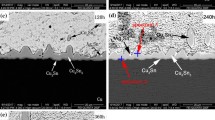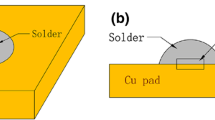Abstract
Cu–xZn wetting layers (x = 0, 20, 30, and 43 wt%) were electroplated in a non-cyanide solution and the interfacial reaction with Sn–3.0Ag–0.5Cu (SAC) solder was investigated after reflow and isothermal aging. After reflow, a Cu6Sn5 intermetallic compound (IMC) formed at the SAC/Cu interface and a small amount of Zn atoms dissolved into the Cu6Sn5 at the SAC/Cu–Zn interface. After aging, Cu3Sn and microvoids were observed between the Cu6Sn5 and Cu layer, whereas such voids were not formed at the SAC/Cu–Zn interface. A dominant reaction product during aging was Cu6(Sn, Zn)5 in the Cu–20Zn and Cu–30Zn samples, which was changed from Cu6(Sn, Zn)5 to Cu(Zn, Sn) in the Cu–43Zn sample. In addition, a thin CuZn IMC was observed beneath the Cu(Zn, Sn) in both the SAC/Cu–30Zn and SAC/Cu–43Zn joints after aging for a long time. X-ray diffraction showed that α-CuZn and β-CuZn peaks were obtained from the Cu–30Zn and Cu–43Zn wetting layers. The crystal structure of Cu(Zn, Sn) and/or CuZn IMCs was a β′-CuZn (ordered phase) with a superlattice peak. As the Zn concentration in the Cu–xZn wetting layers increased to 30 wt%, the IMCs growth rate was gradually reduced, but was increased in the Cu–43Zn sample. The excessive IMC growth of the Cu–43Zn sample was attributed to the fast growth of Cu(Zn, Sn) IMC.







Similar content being viewed by others
References
C.Y. Oh, H.-R. Roh, Y.M. Kim, J.S. Lee, H.Y. Cho, Y.-H. Kim, A new solder wetting layer for Pb-free solders. J. Mater. Res. 24, 297 (2009)
Y.M. Kim, C.-Y. Oh, H.-R. Roh, Y.-H. Kim, A new Cu–Zn solder wetting layer for improved impact reliability, in Proceedings of the Electronic Components and Technolology Conference, vol. 1008 (2009)
M.G. Cho, S.-K. Seo, H.M. Lee, Wettability and interfacial reactions of Sn-based Pb-free solders with Cu–xZn alloy under bump metallurgies. J. Alloys Compd. 474, 510 (2009)
C.-Y. Yu, K.-J. Wang, J.-G. Duh, Interfacial reaction of Sn and Cu–xZn substrates after reflow and thermal aging. J. Electron. Mater. 39, 230 (2010)
Y.M. Kim, H.-R. Roh, S. Kim, Y.-H. Kim, Kinetics of intermetallic compound formation at the interface between Sn–3.0Ag–0.5Cu solder and Cu–Zn alloy substrates. J. Electron. Mater. 39, 2504 (2010)
C.Y. Yu, J.-G. Duh, Growth mechanisms of interfacial intermetallic compounds in Sn/Cu–Zn solder joints during aging. J. Mater. Sci. 47, 6467 (2012)
W.-Y. Chen, C.-Y. Yu, J.-G. Duh, Suppressing the growth of interfacial Cu–Sn intermetallic compounds in the Sn–3.0Ag–0.5Cu–0.1Ni/Cu–15Zn solder joint during thermal aging. J. Mater. Sci. 47, 4012 (2012)
J.H. Lee, Y.M. Kim, J.H. Hwang, Y.-H. Kim, Wetting characteristics of Cu–xZn layers for Sn–3.0Ag–0.5Cu solders. J. Alloys Compd. 567, 10 (2013)
Y.M. Kim, T.J. Kim, M.Y. Choi, Y.-H. Kim, Interfacial reactions between Sn–3.0Ag–0.5Cu solder and Cu–xZn (x = 0–35 wt%) or Cu–xZn–yNi (x = 20 and 25 wt%, y = 15 and 10 wt%) substrates. J. Alloys Compd. 575, 350 (2013)
Y.M. Kim, S.-C. Kim, Y.-H Kim, An eco-friendly Cu–Zn wetting layer for highly reliable solder joints, in Proceedings of the Electronic Components and Technology Conference, vol. 755 (2013)
C.-Y. Yu, W.-Y. Chen, J.-G. Duh, Improving the impact toughness of Sn–Ag–Cu/Cu–Zn Pb-free solder joints under high speed shear testing. J. Alloys Compd. 586, 633 (2014)
J.-Y. Park, Y.M. Kim, Y.-H. Kim, Improved drop reliability of Sn–Ag–Cu solder joints by Zn addition to a Cu wetting layer. J. Mater. Sci.: Mater. Electron. 26, 5852 (2015)
Y.D. Gamburg, G. Zangari, Theory and Practice of Metal Electrodeposition (Springer, New York, 2011), p. 335
J.W. Dini, Electrodeposition: The Materials Science of Coatings and Substrates (Noyes Publications, Park Ridge, 1993), p. 114
L.F. Senna, S.L. Diaz, L. Sathler, Electrodeposition of copper–zinc alloys in pyrophosphate-based electrolytes. J. Appl. Electrochem. 33, 1155 (2003)
J.-Y. Sun, D.-H. Hong, K.-O. Ahn, S.-H. Park, J.-Y. Park, Y.-H. Kim, Adhesion study between electroless seed layers and build-up dielectric film substrates. J. Electrochem. Soc. 160, D107 (2013)
L.F. Senna, S.L. Diaz, L. Sathler, Hardness analysis and morphological characterization of copper–zinc alloys produced in pyrophosphate-based electrolytes. Mater. Res. 8, 275 (2005)
C.Y. Yu, J.-G. Duh, Stabilization of hexagonal Cu6(Sn, Zn)5 by minor Zn doping of Sn-based solder joints. Scr. Mater. 65, 783 (2011)
D.R. Flanders, E.G. Jacobs, R.F. Pinizzotto, Activation energies of intermetallic growth of Sn–Ag eutectic solder on copper substrates. J. Electron. Mater. 26, 883 (1997)
K. Zeng, R. Stierman, T.C. Chiu, D. Edwards, K. Ano, K.N. Tu, Kirkendall void formation in eutectic SnPb solder joints on bare Cu and its effect on joint reliability. J. Appl. Phys. 97, 024508 (2005)
M.G. Cho, S.K. Kang, D.-Y. Shih, H.M. Lee, Effects of minor additions of Zn on interfacial reactions of Sn–Ag–Cu and Sn–Cu solders with various Cu substrates during thermal aging. J. Electron. Mater. 36, 1501 (2007)
R. Juškėnas, V. Karpavičienė, V. Pakštas, A. Selskis, C. Kapočius, Electrochemical and XRD studies of Cu–Zn coatings electrodeposited in solution with d-mannitol. J. Electroanal. Chem. 602, 237 (2007)
C. Kittel, Introduction to Solid State Physics, 6th edn. (Wiley, New York, 1986), p. 584
M. Hansen, K. Anderko, Constitution of Binary Alloys (McGraw-Hill, New York, 1958), p. 649
R. Weil, C.C. Nee, J.W. Chang, Pulsed electrodeposition of layered brass structures. Metall. Trans. A 19, 1569 (1988)
Y. Fujiwara, H. Enomoto, Electrodeposition of β′-brass from cyanide baths with accumulative under potential deposition of Zn. J. Electrochem. Soc. 147, 1840 (2000)
D.R. Frear, W.B. Jones, K.R. Kinsman, Solder Mechanics (The Minerals, Metals, & Materials Society, Pennsylvania, 1991), p. 55
D.A. Porter, K.E. Easterling, M.Y. Sherif, Phase Transformations in Metals and Alloys, 3rd edn. (CRC Press, New York, 2009), p. 95
Y.K. Jee, Y.H. Ko, J. Yu, Effect of Zn on the intermetallics formation and reliability of Sn–3.5Ag solder on a Cu pad. J. Mater. Res. 22, 1879 (2007)
G.K. Sujan, A.S.M.A. Haseeb, M.A. Amalina, H. Nishikawa, Ball shear strength and fracture modes of lead-free solder joints prepared using nickel nanoparticle doped flux. Electron. Mater. Lett. 11, 452 (2015)
J. Yu, J.Y. Kim, Effects of residual S on Kirkendall void formation at Cu/Sn–3.5Ag solder joints. Acta Mater. 56, 5514 (2008)
J.Y. Kim, Y.C. Sohn, J. Yu, Effect of Cu content on the mechanical reliability of Ni/Sn–3.5Ag system. J. Mater. Res. 22, 770 (2007)
Acknowledgments
This work was supported by a National Research Foundation of Korea (NRF) grant funded by the Korea government (MEST) (No. 2011-00015735) and by the practical application project of Multi-layered composite packaging program (Grant Code #: 10041083) of Korea Electronics-machinery Convergence Technology Institute, funded by the Ministry of Knowledge Economy.
Author information
Authors and Affiliations
Corresponding author
Rights and permissions
About this article
Cite this article
Park, JY., Kim, Y.M. & Kim, YH. Effect of Zn concentration on the interfacial reactions between Sn–3.0Ag–0.5Cu solder and electroplated Cu–xZn wetting layers (x = 0–43 wt%). J Mater Sci: Mater Electron 27, 5916–5924 (2016). https://doi.org/10.1007/s10854-016-4510-9
Received:
Accepted:
Published:
Issue Date:
DOI: https://doi.org/10.1007/s10854-016-4510-9




